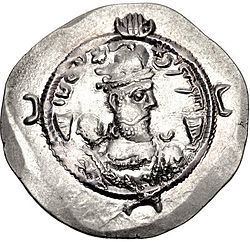Reign 590–591 Father Bahram Gushnasp Parents Bahram Gushnasp Predecessor Khosrow II | Dynasty Sasanian Empire Religion Zoroastrianism Successor Khosrow II | |
 | ||
Died 591 AD, Fergana, Uzbekistan Houses Sasanian Empire, House of Mihran Similar Khosrow II, Bahram V, Ariobarzanes of Persis, Babak Khorramdin, Tughril | ||
Bahr m ch bin
Bahrām Chōbīn (Middle Persian: ; Persian: بهرام چوبین), also known by his epithet Mehrbande (Middle Persian: Mihrewandak), was a famous spahbed (senior army commander) during late sixth-century Iran. He usurped the Sasanian throne from Khosrow II, ruling for a year as Bahram VI (590-591). However, he was later defeated by Khosrow II and was forced to flee.
Contents
Family
Bahram Chobin was son of Bahram Gushnasp, of the House of Mihran, one of the seven Parthian clans of the Sasanian Empire. Bahram Chobin had three siblings whom were named: Gordiya, Gorduya and Mardansina.
Rise
Bahram Chobin originally started his career as marzban of Rey, but in 572 he commanded a cavalry force which captured a Byzantine fortress and was promoted to army chief (spahbed) of Adurbadagan and Media. After being promoted he fought a long, indecisive campaign against the Byzantines in northern Mesopotamia.
In late 588, the massive army of the Göktürks invaded the eastern provinces of the Sasanian Empire, reaching as far as Badghis and Herat. Bahram Chobin was elected as the spahbed of Khorasan and commander-in-chief to lead 12,000 Sasanian forces against the Turks. After reaching Central Asia his army ambushed a large army of Turks and conquered Balkh. He then crossed the Amu Darya and trapped and defeated the Turks near Bukhara, killing the Göktürk Bagha Qaghan with an arrow.
After his great victory against the Turks he was sent to Caucasus to repel an invasion of nomads, possibly the Khazars. Bahram was once again victorious. Bahram Chobin was then made commander of the Sasanian forces against the Byzantines once again, and successfully defeated a Byzantine force in Georgia. However, he later suffered a minor defeat by a Byzantine army on the banks of the Aras.
After his defeat, Hormizd IV disgraced him; he removed Bahram Chobin from the Sasanian office. Thus, he along with the main Persian army, rebelled against the Shah in 589 and marched toward Ctesiphon. Hormizd was killed and his son, Khosrow II, unable to fight such an army, fled to Byzantine territory and Bahram became emperor.
Hormizd IV tried to organize an effective resistance against Bahram Chobin. The Sasanian aristocracy, however, did not support him—not even the religious leaders did. Hormizd IV responded by imprisoning many Sasanian nobles, however, it did not make the situation better, because the Sasanian aristocracy revolted against him and freed the imprisoned nobles. Hormizd IV was blinded and Khosrow II became emperor; however, Bahram Chobin wanted the throne for himself, he defeated the army of Khosrow II around the Zagros Mountains, capturing his uncle Vinduyih. However, Khosrow II and his uncle, Vistahm, escaped. Vinduyih later escaped from his prison and fled over to Khosrow II.
Reign
Vinduyih was sent with a large army granted by Byzantine emperor Maurice. They went to Armenia to outflank Bahram, who was defeated in the lowlands and lost Ctesiphon. He retreated to Azerbaijan and then wrote a letter to Mushegh II Mamikonian, an Armenian spahbed who was helping Khosrow II, the letter said: "As for you Armenians who demonstrate an unseasonable loyalty, did not the house of Sasan destroy your land and sovereignty? Why otherwise did your fathers rebel and extricate themselves from their service, fighting up until today for your country?" Bahram Chobin in his letter promised that the Armenians would become partners of the Sasanian Empire ruled by a Parthian dynastic family if he accepted his proposal to betray Khosrow II. Musel, however, rejected the offer.
Khosrow II's army then marched towards Azerbaijan and defeated Bahram Chobin at the Battle of Blarathon, forcing him to flee to the eastern parts of Persia. While Bahram Chobin was fleeing to the east he defeated the army of the House of Karen of Hyrcania and later arrived in Fergana where he was received honorably by the khagan of the Göktürks. Khosrow II, however, could not feel secure as long as Bahram Chobin lived, and succeeded in having him assassinated. The remainder of Bahram's troops returned to northern Iran and joined the rebellion of Vistahm which took place in 590/1–596 or 594/5–600.
The fate of his family
After Bahram's death, his sister Gordiya traveled to Khorasan, where she married Vistahm, who during that time was also rebelling against Khosrow II. She later killed the latter and joined Khosrow II, who took her as his wife.
Bahram had three sons named Shapur, Mihran Bahram-i Chubin, and Noshrad. Shapur continued to oppose the Sasanians and later joined the rebellion of Vistahm. After the end of the rebellion, Shapur was executed. Mihran is mentioned in 633 as the head of a Sasanian army and fought against the Arabs during the Muslim conquest of Persia. Not much is known about Noshrad, except that he had a son named Toghmath, whose descendants would later rule the Samanid Empire.
Legacy
There are many fables attributed to Bahram VI, as is the normal for many heroes in Persian literature. The chapters in Volume VIII of Ferdowsi's 11th-century Shahnameh on the reigns of "Hormizd, Son of Khosrow I," and "Khosrow Parviz," both of which are almost as much about Bahram Chobin as about Hormizd or his son.
Following the collapse of the Sasanian Empire, the Samanid dynasty formed of descendants of Bahram Chobin, became one of the first independent Iranian dynasties.
